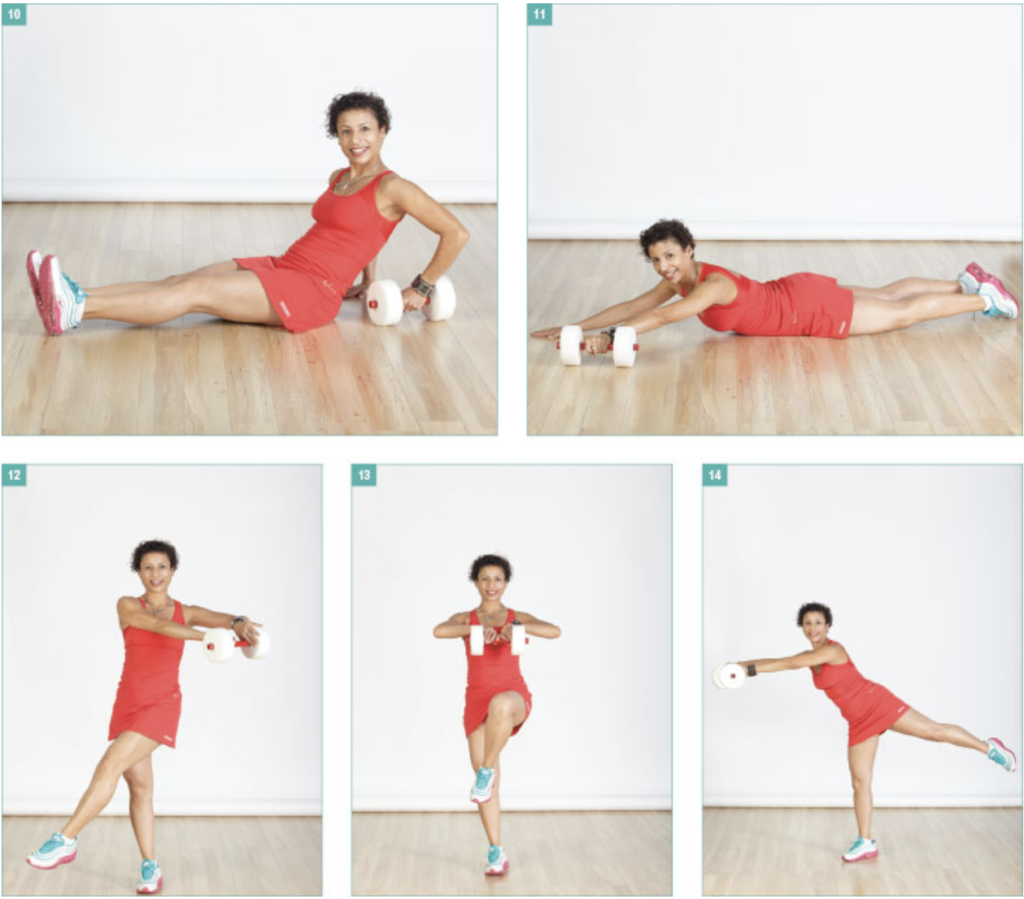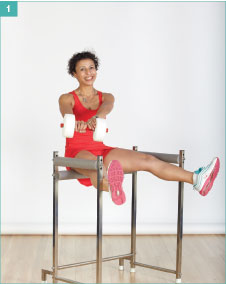Author – Marietta Mehanni – ePublication of Australian Fitness Network – Resources Library.

By combining the instability of single dumbbell workout with the core-activating effects of the deep water environment you can deliver a truly challenging and engaging class, writes Marietta Mehanni.
What a wonderful feeling it is to be weightless and suspended, literally floating in liquid. No other conventional form of group exercise or fitness program comes close to the unique feeling of exercising in deep water. The sensation of reaching down with your feet but not touching anything solid challenges the neuromuscular system that has had a lifetime of familiarity with the effects of gravity. In fact, proprioception can be so altered that exercising in deep water can be very effective at improving coordination and neuromuscular function.
All of Newton’s Laws play an important role in deep water exercise, but most significantly the third law: ‘Every action has an equal and opposite reaction’. Any movement that requires a limb to reach in front of the body will have the effect of pushing the rest of the body backward. In the exact same manner, any movement that extends behind the body will instigate forward movement. In essence, if the desired effect is to stay still (not travelling forwards or backwards in the water), equal force is required to the front and back of the body. Thus utilising this law creates the potential to work opposing muscles equally.
THE AQUA DUMBBELL
Synonymous with aqua exercise, the aqua dumbbell enables a large variety of moves in the pool, and can be used to:
- Create resistance to strengthen the upper body
- Create buoyancy assisted and supported exercises to change the position of the body in the water
- Create turbulence to make stability exercises more challenging
- Create instability when only one dumbbell is in use.
The final point is one of the biggest advantages of using only one dumbbell, as it challenges each side of the body differently and has a more functional application to stability training.
STABILITY TRAINING IN THE WATER
One of the benefits of exercising in water is that it is a supportive, safe environment. Stability training can be performed in water by creating turbulence and thus challenging the body to either stay still or move in a desired direction that is not assisted by turbulence. Adding the use of a single dumbbell creates further instability as the buoyancy assistance to only one side of the body causes the opposite side to work harder to find equilibrium. The result is an overall body workout that consistently recruits the core muscles to develop the power required to drive the limbs through the water in the desired direction.
INDIVIDUAL ARM STRENGTH
When two dumbbells are used, the stronger, more able arm will often compensate for the weaker side. When only one dumbbell is in use, a difference in strength is highlighted. This is advantageous for the client, instructor and personal trainer, as muscle imbalances can be observed and rehabilitated. It also creates an opportunity for the body to develop an awareness of what is ‘not working’ and to correct the undesirable action by recruiting the appropriate muscles.
CORE, CORE, CORE…
When a healthy body moves, the core is activated as the power transfers from the limbs through the torso. Effective interaction between the core and locomotory muscles has a crucial impact on how an exercise is performed, as it enables multi-planar movement without compromising joints or the spine.
It is vital that the communication between core and global muscles is seamless, as this will ensure that functional everyday activities such as standing, pushing a shopping trolley and hanging out washing can be carried out without unnecessary strain being placed on the body.
Research has shown lack of activation of the pelvic floor and transverse abdominals to be a major cause of back issues and injuries. In fact, the first of the core muscles to trigger is the pelvic floor, which coordinates the functioning of all the other core muscles. When activated, it effectively kick-starts transverse abdominus and, in conjunction with the other core muscles, assists with maintaining optimal spinal alignment.
When moving a single dumbbell in a weightless environment, the body will also move. To maintain a desired position, the participant needs to work against the pull of the turbulence. For example, when circling the dumbbell in a horizontal circle, the body will move laterally (which is desirable), but also begin to lean over to the opposite side (undesirable). When encouraged to maintain an upright position, the participant must use their local and global muscles to bring the body into alignment. Another example is when transferring power from the upper body to the lower body or vice versa. One example of this is the one dumbbell rock’n’roll when the body is being flipped forward and back. To successfully perform this exercise, the arms need to pull/push through the water to create the momentum required to move the lower body into position. The effort necessary to transfer power from the upper body to the lower body makes this a very strong core workout.
HOW TO HOLD A SINGLE DUMBBELL
You may be using only one dumbbell, but it can be held in a number of ways.
DOUBLE GRIP
The dumbbell can be held with both hands in either the vertical or horizontal position. To be able to hold the dumbbell in either position, the ‘bar’ needs to be long enough for both hands to fit side-by-side comfortably. Because both hands are driving the dumbbell through the water, faster and more explosive movements can be performed.
FOAM GRIP
A foam grip is when both hands grip the foam parts of the dumbbell. This means that the dumbbell can only be held in a horizontal position. If the foam sections are large, it could be an issue for participants who have arthritis, wrist problems or RSI as the fingers would need to be spread wider and grip harder to maintain control.
HAND-TO-HAND PASS
The dumbbell is passed from one hand to the other. This can be performed with the dumbbell in either the vertical or horizontal position. This allows the fingers and the muscles in the forearms to release, which is necessary when using the dumbbell throughout the class. It requires more coordination because the legs are also usually moving, sometimes in the opposite direction.
To ensure a smooth transition from one hand to the other, both arms need to move through the same plane of movement (saggital, frontal, transverse). If arms are alternating, for example forwards and backwards with a kick to the front, it is very hard to pass the dumbbell from one hand to the other. An alternative option is to have a transitional move that allows both hands to grip the dumbbell, so that the dumbbell is easily passed to the opposite hand.
LEG GRIP
The dumbbell can also be held between the thighs (half way up), or under the knee, between the calf and hamstrings. This is effective for incorporating core stabilisers more actively and for focusing on dumbbell-free upper body exercises. It is also a great way to give the fingers and hands a break from gripping the dumbbells for lengthy periods of time.
WHERE TO START
Begin with standard moves that are used in a regular workout and apply the single dumbbell concept. This will gradually introduce participants to exercises that require more balance, proprioception, coordination and core stability.
Exercises like rock’n’roll (suspended exercise with the body flipping from a prone to supine position and back again) can be performed with two dumbbells, noodles or aqua belt, but is much more challenging with one dumbbell.
Using a single dumbbell with a double grip can make some traditional dual dumbbell exercises easier to perform, for example the side-to-side kick with dumbbells pushing to the opposite side. With two dumbbells, this exercise takes a longer time to perform and requires considerable strength, whereas with one dumbbell there is some upper body resistance, but it can be performed faster, thus maintaining heart rate and core temperature.
STRUCTURING A DEEP WATER CLASS WITH ONE DUMBBELL
One of the greatest challenges faced by instructors is planning a class with a variety of exercises that will keep participants engaged and challenged. Many moves can feel very different when a range of arm patterns is utilised. For example, a cross country ski move can use any of the following arm patterns:
- Open and close chest fly with the dumbbell staying in one hand
- Open and close chest fly with the dumbbell alternating hands
- Both hands on the dumbbell moving from side-to-side
- Push forward and tricep kick back with the dumbbell staying in one hand
- Push forward and tricep kick back with the dumbbell alternating hands.
Each of these exercises changes the turbulence created in the water, which in turn shifts the emphasis of the muscles used to stabilise the body. This makes each exercise unique, even though the same leg action is used for each exercise.
It is also advisable to balance the time spent using the dumbbell with one hand, with exercises that require both hands to hold it. In addition to avoiding excessive fatigue in local muscles, particularly the fingers and forearm, interchanging single grip and double grip moves constantly stimulates the nervous system, making it not just a ‘body’ workout, but also a ‘mind’ one.
CHOREOGRAPHY

Sitting V kick, heels coming together – both hands holding dumbbell in horizontal position and push to each leg (photos 1, 2 & 3).
Dumbbell under the knee, kick the other foot forward and down – both arms scooping across the body in the opposite direction to the knees (photos 4 & 5).
Dumbbell under the right knee, lying on the right side pull the left knee into chest and kick out to the side – both arms scooping water over hips and reaching across the body (photos 6 & 7).
Jogging – dumbbell in right or left hand moving forward and back (photos 8 & 9).
Rock’n’Roll – dumbbell in either the right or left hand or alternating from one hand to the other (photos 10 & 11).
Cross leg over and kick to the side – both hands on the dumbbell in horizontal position and push to opposite corners of the pool (photos 12, 13 & 14).

Marietta is an award winning presenter and Australian Fitness Network Ambassador with over 20 years of teaching and presenting experience in both land- and water-based group exercise. Co-creator of ‘Tricks, tools and trades of Program Coordinating’ and mentor for over 70 instructors and presenters, Marietta is passionate about inspiring others to lead and share their skills and talents to create a better fitness experience for all. For more information visit www.mariettamehanni.com
